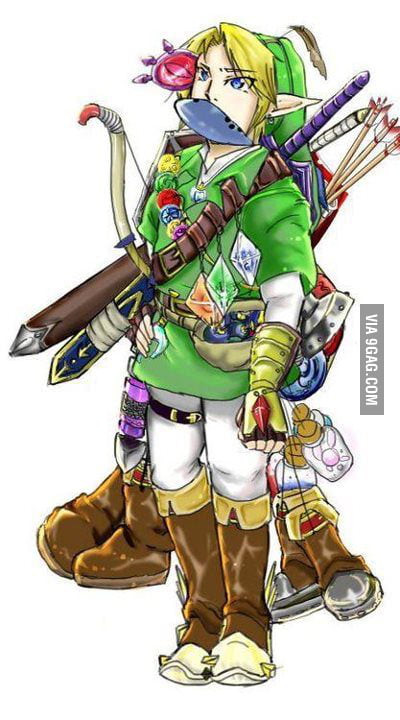In art—especially fan art—what you can't see is just as important as what you can see.
If you remember nothing else from this post, remember that.
I'm a huge proponent of highly detailed art, with realism in the nittiest, grittiest places...but I've discovered that there are some cases where I just can't make things quite as cool as I imagine them.
And that's okay. In fact, if you do it right, leaving things to the imagination can be one of the most effective tools in your cosplay repetoire.
When you do what you can do perfectly, and invite viewers to use their imaginations to fill in what you can't do, they'll imagine those parts are perfect too—more perfect than you could ever make them.
The Power of Imagination
Let me give you a quick example of how this works. When I was in college, I was part of a team that traveled between elementary schools teaching kids confidence through dance. At each school we would put on a performance in a school-wide assembly and then break up to teach individual classes.
Frequently, as I was setting up my class, a group of students would clump around me and the following scene would unfold:
Kid: That was pretty cool what you did on stage. Can you do the windmill?
Me: Yeah.
Kid: Can you do a backflip?
Me: Yeah.
Kid: Can you do a moonwalk?
Me: Yeah.
Kid: Show me!
Obviously, I had these kids' attention and respect. After seeing what I'd done on stage, they imagined my skills were unlimited!
Now, I'm not a liar. I really could do all those things. But if I met their request to "show me" and demonstrated the moves, the kids would walk away disillusioned and I'd have a harder time getting them to participate in the class.
However, if I just answered "Nah, I've got other things in mind" and went on with my lesson, they would continue to hang on my every word.
You see, no matter how good my moonwalk was, it was never as good as they imagined it. By demonstrating my skills they went from unlimited to concrete, and the "wow" factor was gone.
Possibility vs Reality
Film makers use this same principle all the time to enhance the emotional power of their characters. For example, think of a really good movie bad guy...like Emperor Palpatine from the original Star Wars Trilogy.
We know that Palpatine is an extremely powerful Sith Lord, but how? What does he do to prove it?
Absolutely nothing...and that's his secret.
In the first movie, the "Emperor" is simply a name spoken with fear.

In The Empire Strikes Back he appears only as an enormous hologram to which Darth Vader bows.

"Wait! Darth Vader on his knees!?" we think, "What kind of crazy villain is this Emperor guy?" We've seen Vader force-choke officers, quench laser bolts, destroy planets, and seem pretty all-around undefeatable....and yet he's bowing to this mysterious hooded figure.
With that, our imaginations start to run wild. After all, what could be worse than Vader?
By the time Return of the Jedi rolls around, all Palpatine has to do to appear intimidating is sit in his chair, look ugly and let his apprentice do the heavy lifting. Then, at the last moment, he nonchalantly fires evil space lightning from his fingertips and we think "Woah! I've never seen anybody do that before! This guy really is all that!"

And then, before our perfect imagination can be spoiled by any further demonstrations...he dies.
The same sense of mystery makes Palpatine's foil, Yoda, a powerful character. We know he's 900 years old, taught Obi-wan Kenobi, and can deftly raise an X-wing from a swamp. But because that's all we see him do we imagine he can do anything.
But...give these two characters lightsabers and let them spin around for a while, and the illusion is broken.

This is why these scenes from the prequel trilogy were so disappointing. Once we see what they can actually do, their skill with the force goes from abstract and unlimited to concrete and limited. And no matter how impressive Yoda and The Emperor's saber skills were, they could never be as good as we'd imagined them.
Leaving Things to the Imagination
So what has any of this got to do with making a great cosplay costume or other piece of fan art?
Basically, it's okay (and sometimes better) to leave some parts of your creation to the imagination.
Although you should put all the effort you can into perfecting the aspects of your project that you can create, you'll actually come off as more realistic if you leave alone the things that you can't create.
For example, if you build an Iron Man suit that looks like just like in the films, people will imagine that it is also full of gadgets and can fly. But, if you try too hard to build the gadgets in, you'll not only harm the mystique by having to bulk up the suit, but you'll also disillusion people when they see that your wrist-mounted laser pointer just isn't the repulsor cannon they'd hoped for.
The same goes for any magical or technological power that simply doesn't exist in the world today. A perfectly crafted lightsaber replica which swings, deactivated, from a hip looks like it could spring to life and cut through anything. A bright LED blade with authentic humming effects does not.
Suggesting the Impossible in Cosplay
In most cases you're better off suggesting the impossible than stating it in your art.
For example, in our Legend of Zelda cosplay project, we wanted to be as realistic as possible. And, in our quest for realism, we considered recreating all kinds of items from the game that Link carries
The only problem is, if we'd had Link carry all his items, he wouldn't have looked like the Link we all know and love...

When you see the Link you imagine, however, you suspend disbelief the same way you do when playing the game and imagine that all the items must be tucked away in there somewhere.
Similarly, when creating an Air Nomad staff inspired by Avatar: The Last Airbender, I realized that as cool as it would be to have the staff just pop open and closed like in the cartoon, it would bulk up the design to the point where it would no longer look "right."

It may take a couple minutes to open and close the staff, but because it keeps the right proportions and looks good in both positions, it's easy to imagine that the transition between the two is just as ideal.
Since our idea of what magical powers and technological marvels should look like is usually based on extensively edited films and pictures, if you really want to recreate them it's usually best to do so in photos which you can edit in a similar way.
I do a lot of this "magical editing," but even then, when I run into parts of a monster or a scene that I don't feel like I can recreate perfectly, I usually prefer to suggest them instead.
Conclusion
When it comes to creating fan art, less is often more.
Sure, you can visually shout to the whole world about your authentic flame-throwing fire bender costume—and look ridiculous doing it—or you can let your silence speak volumes.
If you do what you can do perfectly and leave what you can't do to the imagination, people will imagine it is perfect too.







